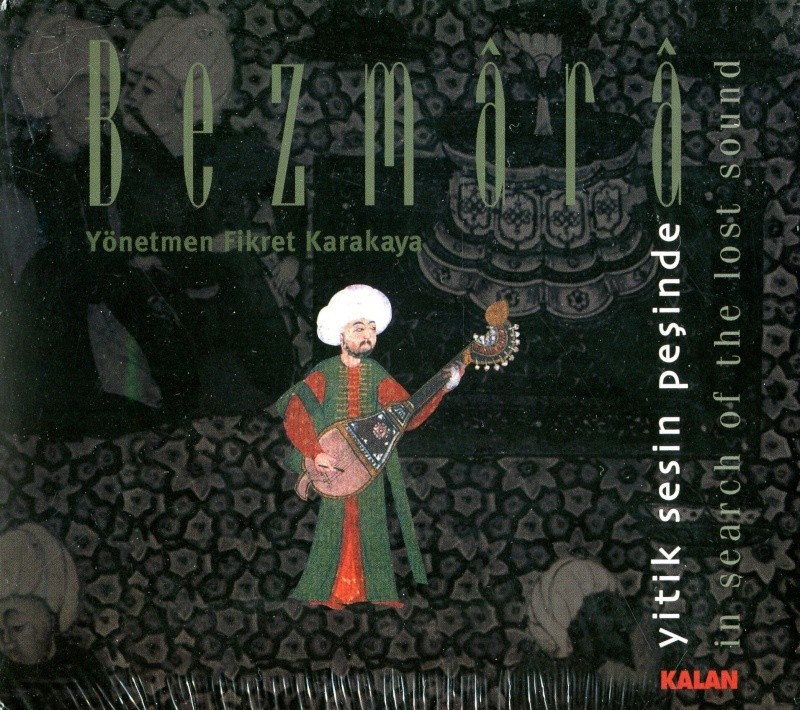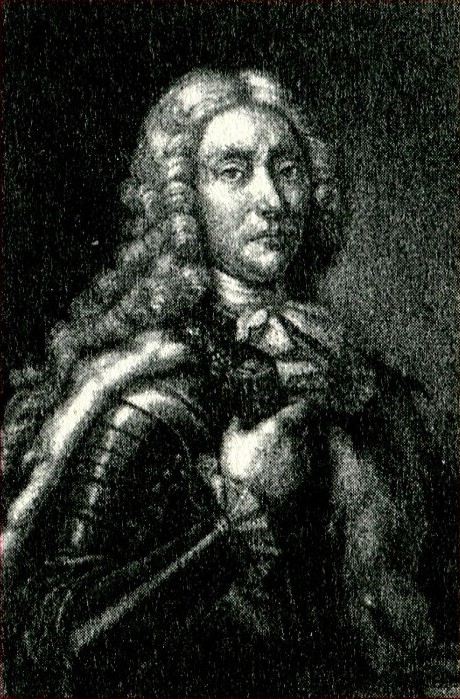Yitik Sesin Peşinde. KANTEMİROĞLU
In Search of the Lost Sound / Bezmârâ

kalan.com
Kalan Music 161
2000
1. Arazbar
Peşrev, fahte / NEFİRÎ BEHRAM [5:15]
çeng, ud, kopuz, şehrud, kanun, ney, kemânçe,
daire, nakkare
2. Hüseynî Peşrev, zencîr / GAZİ GİRAY HAN
[5:08]
kopuz, şehrud, kanun, ney, kemânçe, daire, nakkare
3. Kanun taksimi [1:05]
4. Evc Peşrev, fetih darbı / ACEMLER [2:36]
çeng, ud, kopuz, şehrud, kanun, ney, kemânçe,
daire, nakkare
5. Arazbar Peşrev, devr-i revân / EYYUBÎ MEHMED
ÇELEBİ [6:08]
santur, tanbur, kanun, ney, kemânçe, daire, nakkare
6. Çeng taksimi [1:08]
7. Nişabur Peşrev, sakil / HİNTLİLER [6:16]
çeng, kopuz, şehrud, kanun, ney, kemânçe, daire,
nakkare
8. Çargâh Peşrev, devr-i kebir / DERVİŞ MUSTAFA
[5:46]
santur, tanbur, ney, kemânçe, daire, nakkare
9. Kemânçe taksimi [1:14]
10. Kürdî Peşrev, berefşan / TANBURÎ ANGELİ
[7:22]
santur, tanbur, ney, kemânçe, daire, nakkare
11. Buselik-aşiranı Peşrev, sakil / MUZAFFER [4:38]
tanbur, kanun, ney, kemânçe, daire, nakkare
12. Evc Peşrev, hafif / ZURN AZEN İBRAHİM [3:52]
tanbur, kanun, ney, kemânçe, daire, nakkare
13. Muhayyer Peşrev, muhammes / KANTEMİROĞLU [5:27]
tanbur, derili kanun, ney, kemânçe, daire, nakkare
14. Mahur Semâî, semâî / ANONİM
çeng, ud, tanbur, kanun, ney, mıskal, kemânçe,
daire, nakkare [3:33]
BEZMÂRÂ
Fikret Karakaya
Fikret Karakaya - çeng
Birol Yayla - tanbur, kopuz
A. Senol Filiz - ney
Serap A. Çağlayan - kanun
Kemal Caba - kemânçe
Osman Kırklıçı - şehrud
İhsan Özer - santur
Kâmil Bilgin - daire, nakkare
Tugay Başar - mıskal
Akgün Çöl - ud

Bezmârâ Topluluğu
The Bezmârâ ensemble, specialized in the interpretation of
early Ottoman music, owning instruments some of which have totally
disappeared, was founded in 1996 by Fikret Karakaya on the occasion of
the musicological project whose purpose was to recreate, on ancient
instruments, the compositions which appear in various old collections,
and which contemporary musicians had abandoned.
The French Institute for Anatolian Research and the American
musicologist Walter Feldman hetped to achieve the project. Some
instruments, like the çeng, the şehrud, the kopuz
played at the Ottoman court, the metal stringed kanun, the pear
shaped tanbur and the ud with "cheeks" which do not
appear in any museum or private collection, were produced in the style
of miniatures or written sources. Some of these instruments had not
been used for three centuries, others for four. Nor is there any
indication about the way they were played.
Fikret Karakaya, who plays the kemançe at the İstanbul
Radio since 1982, has undertaken to discover the technique of the çeng.
The famous tanbur player, Birol Yayla, succeeded the first day
he tried the kopuz in obtaining a faultless sound. As these two
instruments never coexisted, Birol Yayla could play both tanbur
and kopuz. The style of the renowned ney player Şenot
Filiz was quite suitable for playing these works. Serap
Çağlayan, who plays the modern kanun, didn't take much
time in getting used to the 16th century metal stringed kanun.
Kemat Caba, a violinist at the İstanbut Radio since 1982, quickly
reached a high technical level on the kemânçe.
Osman Kırklıkçı, an ud player at the İstanbul Radio
himsefl, adapted very quickly to the şehrud. The kanun
player İhsan Özer was already practising on the modern santur
for some time, therefore it was not very difficutt for him to switch
from the new to the old santur. The flutist Tugay Başar tried
hard to be abte to play the mıskal, a very difficult
instrument. Kâmil Bilgin, who plays the daire and the nakkare,
adapted quickty to the old rhythms. The ud player, Akgün
Çöl, had no difficutty with the ı6th century ud.
The Bezmârâ ensemble, which works on the pieces of music
Cantemir transcribed and which had not been performed for three
centuries gave five concerts in 1998, including one at the Palais de
France in İstanbul and another one in the Topkapı Palace. The ensemble
is continuing its research, so as to increase and vary the scope of the
repertoire.

Kantemiroğlu / Dimitrie Cantemir
The works performed on the enclosed recording belong to the
instrumental repertoire of Ottoman music of the 16th and 17th centuries
anotated down by Dimitrie Cantemir, prince of Moldavia, by the end of
the 17th century.
Cantemir, whose name is engraved together with those of Leibniz and
Newton on the front part of the Sainte-Geneviève Library in
Paris as one of the men who praised the ideal of mankind, was
commemorated in 1973 in several countries of the world under the
sponsorship of UNESCO, for the 3ooth anniversary of his birth; on that
occasion, most of his written works were republished.
Dimitrie Cantemir, quoted in Ottoman sources as "Kantemiroğlu",
"Kantemir" and "Küçük [Small] Kantemiroğlu" was born
on the 5th November, 1673 at laşi, Moldavia. His father Constantin was
a voivode of Moldavia. Dimitrie spent twenty years of his life in
Istanbul where he arrived when very young, pursuant to the agreement
reached by his father and the Ottoman government (the hereditary prince
of Moldavia was to remain in the Ottoman capital as a hostage and to
study there). He carried on with the studies he had started in Iaşi,
learned several languages western as well as eastern, such as Turkish,
Arabic and Persian. He also showed keen interest in Turkish music and
he made such a success therein, and made such a success that the result
was the production of excellent works along the style of the Ottoman
musicians who had been his masters and whose compositions he himself
transcribed. Cantemir, who also wrote books on Ottoman history, Islam,
and the Arabic language, transcribed in his major work Kitab-ı
İlmü'l-Musıki alâ Vechi' l-Hurufât, also more
plainly called KANTEMİROĞLU EDVARI ("Treaty of Cantemir") over
350 instrumental compositions of the 16th and 17th centuries, using a
system of musical notation based on the alphabet that he had developed
himself. These compositions have come down to us thanks to his
treatise. However, the important manuscript did not attract the
attention of musicians and the compositions written by Cantemir fell
into oblivion for nearly three centuries, except for some
transcriptions made in parts by music specialists. The Turkish composer
and musicologist Yalçın Tura started to publish towards the
mid-70's the transcription in latin characters and the translation in
modern Turkish of the treatise, but the fortunate venture remained
uncompleted. It was only in 1992 that the English musicologist Owen
Wright, published all of the compositions contained in Cantemir's
treatise, in a transcription written in line with a system currently in
use in contemporary Turkish music.
Cantemir, who was proclamed voivode of Moldavia in 1710 by the Ottoman
sultan Ahmed III conceived the ideal of a united independent Wallachia
and Moldavia. As a resutt, he did not hesitate to set an alliance with
Russia against the Ottoman empire. But he was forced to escape to
Russia in 1711, seven months after he had been appointed voivode,
following the defeat of the Russian army by the Ottomans at Prut.
Warmly welcomed by the tzar Peter the Great, he is one of the founders
of the Saint Petersburg Art and Science Academy. Also elected in 1714
as a member of the Berlin Academy, Cantemir died on 1st September, 1723
in Kharkov, at the age of 50.
Between 1714 and 1716 he wrote in latin the first Ottoman history based
on first hand sources: Incrementa atque decrementa aulae
othomanicae (The History of the Growth and Decay of the Othman Empire).
His son Antioch, born in Istanbul, a Russian ambassador to London at
that time, had the book translated, and published it after his father's
death, in 1734.
Abbot Toderini, in the service, between 1781 and 1786, of the Venetian
Bayle in Istanbul, Agostino Garzoni, in his book on Turkish literature
entitled Letteratura turchesca shows that Cantemir had written
at the request of Lâtif Çelebi, the palace treasurer and
İsmail Efendi, in charge of the imperial treasure (both of them
amateurs of music), a book in Turkish on musical theory which he
dedicated to Sultan Ahmed II entitled Kitab-ı İlmü' l-Musiki
alâ Vechi' l-Hurufât ("The Book of Musica! Science Using
the Letters of the Alphabet").
In the first part of his book, Cantemir gives information with respect
to Turkish intervals, modes, rhythms and interpretation, as had been
customary in the older treatises. These notes are very important for us
as we thus gain knowledge of Ottoman music prevailing at that time. In
the second part of the book, we find peşrevs and semais - some of them
being compositions by Cantemir himself - transcribed with his own
notation system. Some of these compositions already appear in Ali
Ufkî's* collected works, written approximately fifty years back.
We can profit by this new rendering by comparing the small changes
occuring in these works during the fifty year period. The two
collections are of capital importance not only because they have saved
hundred of works from sinking into oblivion, but also because they have
come down to us in the melodic structure of the period in which they
were transcribed.
The enclosed C.D. presents the first recording of compositions selected
in Cantemir's collection and has been made with a particular concern
with regard to historical authenticity.
______
* The real name of Ali Ufkî is Wojciech Bobowski. A war prisoner
he was brought to Istanbul, and was admited in the seraglio as a
dragoman. Of Polish origin, he converted to Islam and assumed the name
of Ali Ufkî. He already knew several western languages and was
able to learn to speak Turkish, Arabic and Persian in the palace. Being
very talented in music, he had learnt in Poland to transcribe melodies
an paper and to read music written by other musicians. As he was very
fond of Ottoman music, he tried to learn it perfectly and compose works
along that style. He left us a collection of over 60o works, vocal as
well as instrumental, some of them being his own compositions. Written
in the middle of the 17th century, the collection called MecmûQ-i
Sâz U Söz ("Collection of notes and texts") represents the
oldest record of notes not only of Ottoman music, but also of all the
Eastern
compositions. The autograph manuscript of the Mecmûa, removed
from Istanbul when Ali Ufkî was
probably still alive, is now in the British Museum. It is only during
the past quarter of a century that the manuscript, of capital
importance as far as Ottoman music is concerned, has been attracting
the attention of Turkish music experts.




